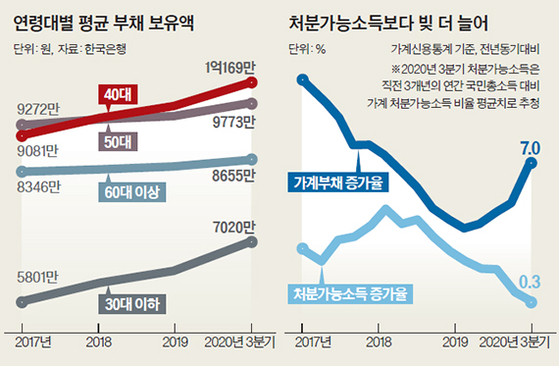It was found that household loans for young people in their 20s and 30s increased at a faster rate compared to other age groups. It is analyzed by the impact of the increase in the number of young people who are engaged in so-called ‘young drag’ and’ debt investment (investing through loans), such as increasing demand for jeon, monthly rent and home purchase, and jumping into stock investment.
In the third quarter of this year, debt increased by 7% from a year ago
2030 is the steepest loan growth
Corporate interest compensation ratio 4.4 → 3.5 times higher
Concerns about crisis when government financial aid ends
– According to the Financial Stability Report submitted by the Bank of Korea to the National Assembly on the 24th, domestic household loans for young adults at the end of the third quarter of this year increased by 8.5% compared to the same period last year. It is a faster increase than the average of other age groups (6.5%). When it comes to the ratio of loans to income (LTI), it stands out even more. Young people’s LTI was 221.1% at the end of the third quarter, up 14.9 percentage points from the end of last year. Compared to the LTI of other age groups, which rose only 6.6 percentage points over the same period.
Average debt holdings by age group
– An official from the BOK analyzed that “this is due to a combination of demand-side factors such as increased demand for real estate and stock investment by young people, and supply-side factors such as expansion of non-face-to-face credit loans with high accessibility and support for jeon/monthly loans for young people.”
However, the BOK estimates that the risk of insolvent household debt for young people is still not significant. The reason is that the proportion of loans from banks with relatively low interest rates is high, and that there are many loans with cheonsei funds paying only interest. In fact, the delinquency rate for household loans among young people is 0.47%, which is better than that of other age groups (0.71%).
For the first time, total household debt surpassed the size of the country’s economy. As of the end of the third quarter of this year, the ratio of household credit to gross domestic product (GDP) was 101.1%. This is the first time household credit has surpassed GDP since statistics were prepared in 2007. Household debt was 168.21 trillion won, an increase of 7.0% from the same period last year. Of these, mortgage loans increased by 7.2%, and other loans (mostly credit loans) also increased by 6.8%. The ratio of household debt to disposable income also rose 10.7 percentage points to 171.3% as of the third quarter. This is the result of debt growth faster than the rate of income growth.
However, the total debt repayment ratio (DSR) of all borrowers was 35.7%, which has been on a steady decline since 2018 (39.6%). This is the result of structural changes, such as falling loan interest rates and prolonged loan maturity. Min Jwa-hong, head of the Bank’s Financial Stability Bureau, diagnosed that “the level of decline in household debt repayment capacity is not as great as the initial concern.”
It was the companies that the BOK expressed concern. The interest compensation ratio of domestic companies, which was 4.4 times in the first half of last year, has decreased significantly to 3.5 times in the first half of this year. The interest coverage ratio is an indicator of a company’s ability to pay interest. If this decreases, it means that profitability and ability to repay loans decline. Sales decreased in the aftermath of Corona 19, but the interest burden increased. If the government extends financial support next year, the proportion of companies with insufficient liquidity will decrease from this year (3%) to 2.5% in the basic situation (sales increase by 5.8%). However, in a pessimistic situation (sales -1.7% decrease), it increases to 4.4%. When financial support is completely terminated, this proportion surges to 5.1% in the basic situation and 7% in the pessimistic situation.
I am also worried about self-employment. If the government’s deferment of repayment of principal and interest ends after April next year, the proportion of deficit households among self-employed households (2437,000 households) will record 20.3% in the’sales recovery scenario’ and 22.4% in the’pessimistic scenario’ in December next year. Is expected. In the worst case, it could exceed the level of last March (21.8%), when the Corona 19 shock was the greatest.
Reporter Jang Wonseok [email protected]
–


